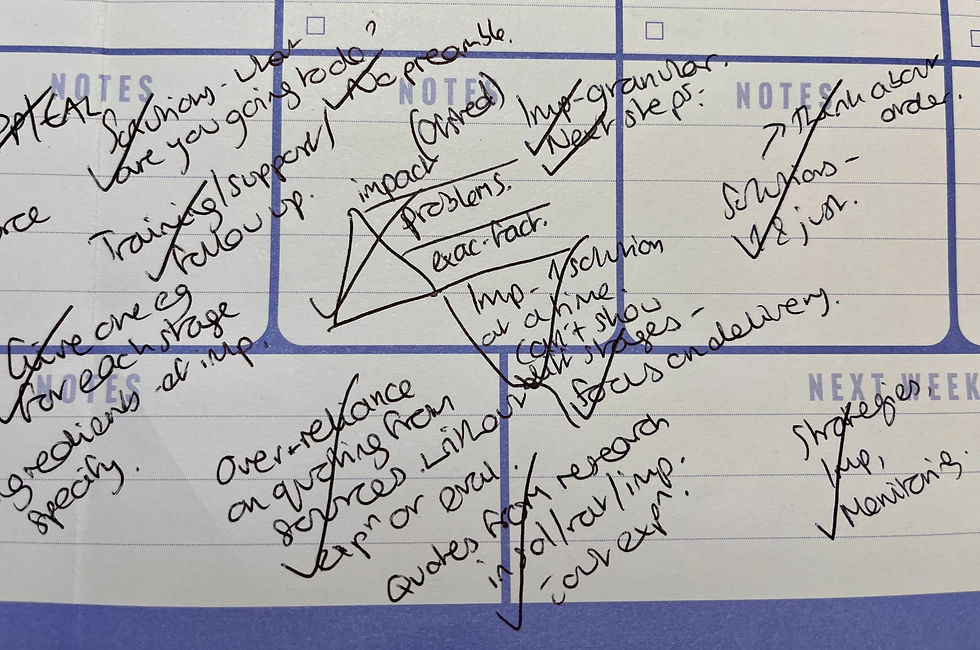Mastering NPQ Summative Assessments
- becca86607
- Jul 29, 2024
- 4 min read
Updated: Aug 4
This summer's hottest new release, aside from Deadpool & Wolverine, was the EEF’s updated implementation guidance, their first update since the original 2018 publication that forms the basis for the implementation section of every NPQ framework. It’s an incredibly useful read that is divided into three main sections:
· How to engage and unite staff around the change;
· How to make sure that what is being implemented is supported contextually;
· Further consideration of each of the four stages of implementation – explore, prepare, deliver, sustain.

My helpful scribbles as I was reading are rather better shown in the EEF's diagram on Page 8, while another diagram on Page 18 is a really helpful visual as well.
Essentially, the first two sections of the updated guidance give some thought to what we might call the enabling conditions for change, and the third section covers the process itself in more detail than the original guidance did.
For the summative assessment for most NPQ providers, implementation is the final part of your response, and it is heavily weighted, so it’s important that you understand change management thoroughly. Also, the best candidates will consider implementation throughout their response, so here I’ll be considering how the revised EEF guidance can be applied to each section.
For more general tips for each section, have a look at my previous blog post from April 2024 here.
1. Identify the problems
An interesting new development in summative assessments by many NPQ providers has been evidence in the case study of a recent poorly implemented change or new approach. This can be something as simple as some staff training that was delivered quickly, without the understanding of those on the receiving end, and with little monitoring of impact.
With the revised thinking from the EEF’s guidance report about the behaviours and contextual factors needed for successful change, this is something to look out for, so you can ask yourself the following questions about the behaviours in the case study:
· Were staff engaged and able to shape what happened?
· Were staff united around the approach?
· Was there enough reflection, monitoring and adaptation afterwards?
Equally, the following contextual questions may help you to identify other problems with how a previous change was implemented:
· Was the right approach implemented, ie was it an evidence-informed decision, was it right for the setting, and was it feasible?
· Was the infrastructure in place to support the approach?
· Were the right people with the right expertise in place to lead the approach?
2. Solutions and rationale
Some NPQ providers separate out the solutions and rationale into two sections, and some combine them in one section of your response.
Either way, a helpful way to think of it is to consider the solutions as covered what you will implement, and the rationale as why this is the best approach. Do make sure you have a look at the percentage weightings or suggested word count from your NPQ provider, as this will support you in giving them the right amount of treatment in your response.
When you’re thinking about your solutions, it’s a good idea even at this stage of your response to bear in mind their implementation, although of course you will cover that in your next section.
The EEF updated guidance is more person-centred, with a focus on collaboration and consideration. So, for example, if you decided one of your solutions would be for subject leaders to review the curriculum with their teams, you might want to show how you had thought about the training subject leaders might need to empower them to do this.
3. Implementation
When you come to this section, there really will be no substitute for reading the EEF’s original implementation guidance, which you can find here: Implementation | EEF
I highly recommend you reading the updated guidance too, which starts with a helpful summary and includes an enormous level of detail under the third recommendation about the stages of implementation itself: A School's Guide to Implementation guidance report | EEF
However, don’t be tempted to rely too heavily on the EEF guidance. It’s really important that you apply its principles to your own case study in order to demonstrate your understanding of it. If your response in this section is generic, it will be noted by the assessor, and they’re unlikely to give a high mark in that case.
Another really important thing here is to check whether your NPQ provider has specified a focus for the implementation section of your response and, if so, make sure you really home in on that. The focus will usually be quite broad, such as one of the phases of implementation, so there’ll still be plenty for you to say.
If you feel like you need a bit more help preparing, click here to see my last blog post on NPQ Summative Assessment Tips.
Or for advice on how to write with precision and clarity of voice in your NPQ summative assessment, click here.
I can also offer one-to-one support that goes into much more detail on the following topics:
· Overall approach
· Features of successful responses for each section
· Common pitfalls for each section
If you were unfortunate enough not to pass last time and are retaking, I can take a detailed look at your submission and any feedback you’ve been given, and I can then offer tailored support to help you prepare this time and pass.

Comments